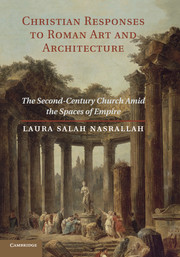 Christian Responses to Roman Art and Architecture
Christian Responses to Roman Art and Architecture Book contents
- Frontmatter
- Contents
- LIST OF FIGURES
- ACKNOWLEDGMENTS
- ABBREVIATIONS
- INTRODUCTION
- PART I FRAMING THE QUESTION, FRAMING THE WORLD
- PART II INTO THE CITIES
- PART III HUMAN BODIES AND THE IMAGE(S) OF GOD(S)
- 5 HOW DO YOU KNOW GOD? ATHENAGORAS ON NAMES AND IMAGES
- 6 WHAT DO WE LEARN WHEN WE LOOK? (PART I) IMAGES, DESIRE, AND TATIAN'S TO THE GREEKS
- 7 WHAT DO WE LEARN WHEN WE LOOK? (PART II) APHRODITE AND CLEMENT OF ALEXANDRIA
- EPILOGUE
- BIBLIOGRAPHY
- INDEX LOCORUM
- INDEX
- References
6 - WHAT DO WE LEARN WHEN WE LOOK? (PART I) IMAGES, DESIRE, AND TATIAN'S TO THE GREEKS
from PART III - HUMAN BODIES AND THE IMAGE(S) OF GOD(S)
- Frontmatter
- Contents
- LIST OF FIGURES
- ACKNOWLEDGMENTS
- ABBREVIATIONS
- INTRODUCTION
- PART I FRAMING THE QUESTION, FRAMING THE WORLD
- PART II INTO THE CITIES
- PART III HUMAN BODIES AND THE IMAGE(S) OF GOD(S)
- 5 HOW DO YOU KNOW GOD? ATHENAGORAS ON NAMES AND IMAGES
- 6 WHAT DO WE LEARN WHEN WE LOOK? (PART I) IMAGES, DESIRE, AND TATIAN'S TO THE GREEKS
- 7 WHAT DO WE LEARN WHEN WE LOOK? (PART II) APHRODITE AND CLEMENT OF ALEXANDRIA
- EPILOGUE
- BIBLIOGRAPHY
- INDEX LOCORUM
- INDEX
- References
Summary
The paidagŌgos is a slave, often described as greek, who led the children of the elites to school and back home. In this chapter and the next, I shall discuss images as pedagogical not only because I treat ancient discussions of what Roman-period images of the bodies of humans and gods teach, but also because I discuss Greek objects that were purchased, stolen, replicated, interpreted, and displayed by Roman elites. These anthropomorphic images – images of humans, often as gods, or gods as humans – are like the enfleshed and owned paidagōgos: Both statue and slave are simultaneously objects and persons, or like persons.
Statues take the viewer by the hand and try to lead her or him somewhere. “In a landscape of having to repeat,” images, particularly Greek or Hellenizing statuary bodies, are thus like the Greek paidagōgos's body: far from home, enslaved, leading the eyes in various ways to learn about Greek paideia through the lens of Roman domination. At the same time, Greek images stolen and copied by Rome demonstrate that the colonized may have some kind of superiority and power to lead or even to enslave the viewer with iconographic power. Just as the Greek language was the koinē or common language of elites in the eastern portion of the Roman Empire, so also Greek images, from classical to Hellenistic, were the semantic foundation of much of Roman iconography.
- Type
- Chapter
- Information
- Christian Responses to Roman Art and ArchitectureThe Second-Century Church amid the Spaces of Empire, pp. 213 - 248Publisher: Cambridge University PressPrint publication year: 2010


